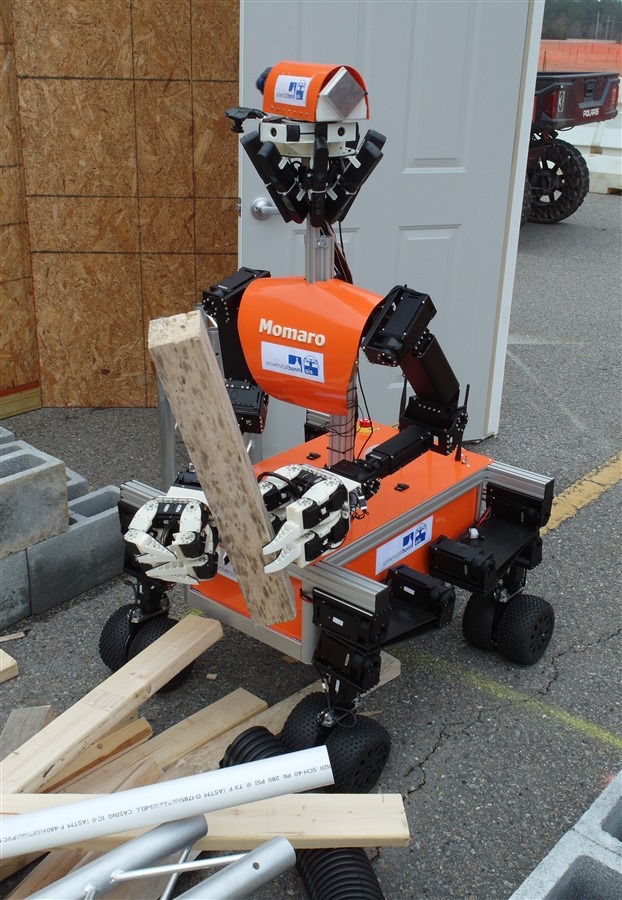Meet the Robot Finalists in the DARPA Robotics Challenge

This week, students and engineers from around the world will descend on Southern California for two days of good old-fashioned robot mayhem.
A total of 25 teams will compete in the DARPA Robotics Challenge Finals, a competition to design robots that could one day help respond to a natural or man-made disaster. The competition, hosted by the Defense Advanced Research Projects Agency, the military's R&D branch, is open to the public and takes place June 5 and 6 in Pomona, California.
The winning team will take home $2 million. The runner-up and third-place teams will receive $1 million and $500,000, respectively. [See images from the DARPA Robotics Challenge Trials]
In December 2013, 16 teams competed in the DARPA Robotics Challenge Trials in Florida, and 11 teams were selected to move on to the finals. In March, 14 other teams qualified to take part in the competition. The teams hail from countries around the globe, including the United States, Japan, China, South Korea, Hong Kong, Germany and Italy.
For instance, there's Team RoboSimian from NASA's Jet Propulsion Laboratory in Pasadena, California. This team's apelike robot will use its four limbs to remain stable and avoid tipping over. This could be a boon in the competition, because the robots will not be tethered as they try to complete the various tasks.
Then there's Carnegie Mellon University's team Tartan Rescue, whose CHIMP robot took third place in the 2013 DARPA Robotics Challenge Trials. The bot has a humanlike shape, but rolls on rubberized tracks like a tank, which helps it move over uneven terrain.
From Japan's National Institute of Industrial Science and Technology comes Team AIST-NEDO, whose HRP2+ robot boasts such abilities as walking two-legged on rough terrain, lying down and getting up, falling safely, passing through narrow passages, manipulating objects while supporting itself, and dancing in traditional Japanese style. It also looks a bit like the robot from the film "Chappie."
Sign up for the Live Science daily newsletter now
Get the world’s most fascinating discoveries delivered straight to your inbox.
China's Team Intelligent Pioneer is bringing their robot Xing Tian, named after an ancient Chinese mythical hero. The humanoid bot was originally designed to be a household aide, doing housework and taking care of children and the elderly, team members said.
Team KAIST, from South Korea, has its DRC-HUBO robot, the latest version of the HUBO bot, which has been under development since 2002. HUBO, which stands for "Humanoid robot," can walk upright, but can also move to a kneeling position, in which it drives on wheels to move quickly.
From Germany comes the University of Bonn's Team NimbRo Rescue, whose Momaro robot has a humanoid torso on top of four flexible, wheeled legs. This allows the bot to drive on uneven terrain, as well as climb stairs. The robot's head also contains a 3D laser scanner and a dozen cameras that can let it see in all directions.
In addition to the teams above, another 19 teams will take part in the competition. Here is a full list of the competitors (in no particular order):
1. TARTAN RESCUE — Carnegie Mellon University, Pittsburgh. Robot name: "CHIMP."
2. TEAM AERO — Tokyo. Robot name: "Aero DRC."
3. TEAM AIST-NEDO — National Institute of Industrial Science and Technology, Japan. Robot name: "HRP2+."
4. TEAM DRC-HUBO AT UNLV — University of Nevada Las Vegas. Robot name: "Metal Rebel."
5. TEAM GRIT — Grand Junction, Colo.; Morton, Ill.; Moscow, Idaho. Robot name: "Cog-Burn."
6. TEAM HECTOR — Technische Universität (TU) Darmstadt, Germany. Robot name: "Johnny 05."
7. TEAM HKU — The University of Hong Kong, China. Robot name: "Atlas."
8. TEAM HRP2-TOKYO — Jouhou System Kougaku Laboratory, Tokyo. Robot name: "HRP-2."
9. TEAM IHMC ROBOTICS — Institute of Human and Machine Cognition, Pensacola, Florida. Robot name: "Running Man" (Atlas).
10. TEAM INTELLIGENT PIONEER — Institute of Advanced Manufacturing Technology, Changzhou, China. Robot name: " Xing Tian."
11. TEAM KAIST — Rainbow Co. and KAIST, Daejeon, South Korea. Robot name: "DRC-HUBO."
12. TEAM MIT — Massachusetts Institute of Technology, Cambridge, Massachusetts. Robot name: "Helios" (Atlas).
13. TEAM NEDO-HYDRA — The University of Tokyo, Chiba Institute of Technology, Osaka University, Kobe University; Tokyo. Robot name: "Hydra."
14. TEAM NEDO-JSK — University of Tokyo. Robot name: "Jaxon."
15. TEAM NIMBRO RESCUE — University of Bonn, Germany. Robot name: "Momaro."
16. TEAM ROBOSIMIAN — Jet Propulsion Laboratory, Pasadena, California. Robot name: "RoboSimian."
17. TEAM ROBOTIS — ROBOTIS, Korea Tech University and Korea Robotics Society, Seoul, South Korea. Robot name: "Thormang."
18. TEAM SNU — Seoul National University, Suwon-si, Gyeonggi-do, South Korea. Robot name: "Thormang."
19. TEAM THOR — University of California, Los Angeles; University of Pennsylvania, Philadelphia. Robot name: "THOR-RD."
20. TEAM TRAC LABS — TRACLabs, Webster, Texas. Robot name: "Hercules" (Atlas).
21. TEAM TROOPER — Lockheed Martin Advanced Technology Laboratories; Cherry Hill, New Jersey; Troy, New York; Philadelphia. Robot name: "LEO" (Atlas).
22. TEAM VALOR — Virginia Tech, Blacksburg, Virginia. Robot name: "ESCHER."
23. TEAM VIGIR — TORC Robotics, Technische Universität (TU) Darmstadt, Germany; Virginia Tech, Blacksburg, Virginia; Oregon State University, Corvallis, Oregon; Cornell University, Ithaca, New York; Leibniz University, Hanover, Germany. Robot name: "Florian."
24. TEAM WALKMAN — Italian Institute of Technologyand University of Pisa, Genova-Pisa, Italy. Robot name: "WALK-MAN."
25. TEAM WPI-CMU — Worcester Polytechnic Institute, Worcester, Massachusetts; Carnegie Mellon University, Pittsburgh. Robot name: "WARNER" (Atlas).
Follow Tanya Lewis on Twitter. Follow us @livescience, Facebook & Google+. Original article on Live Science.











